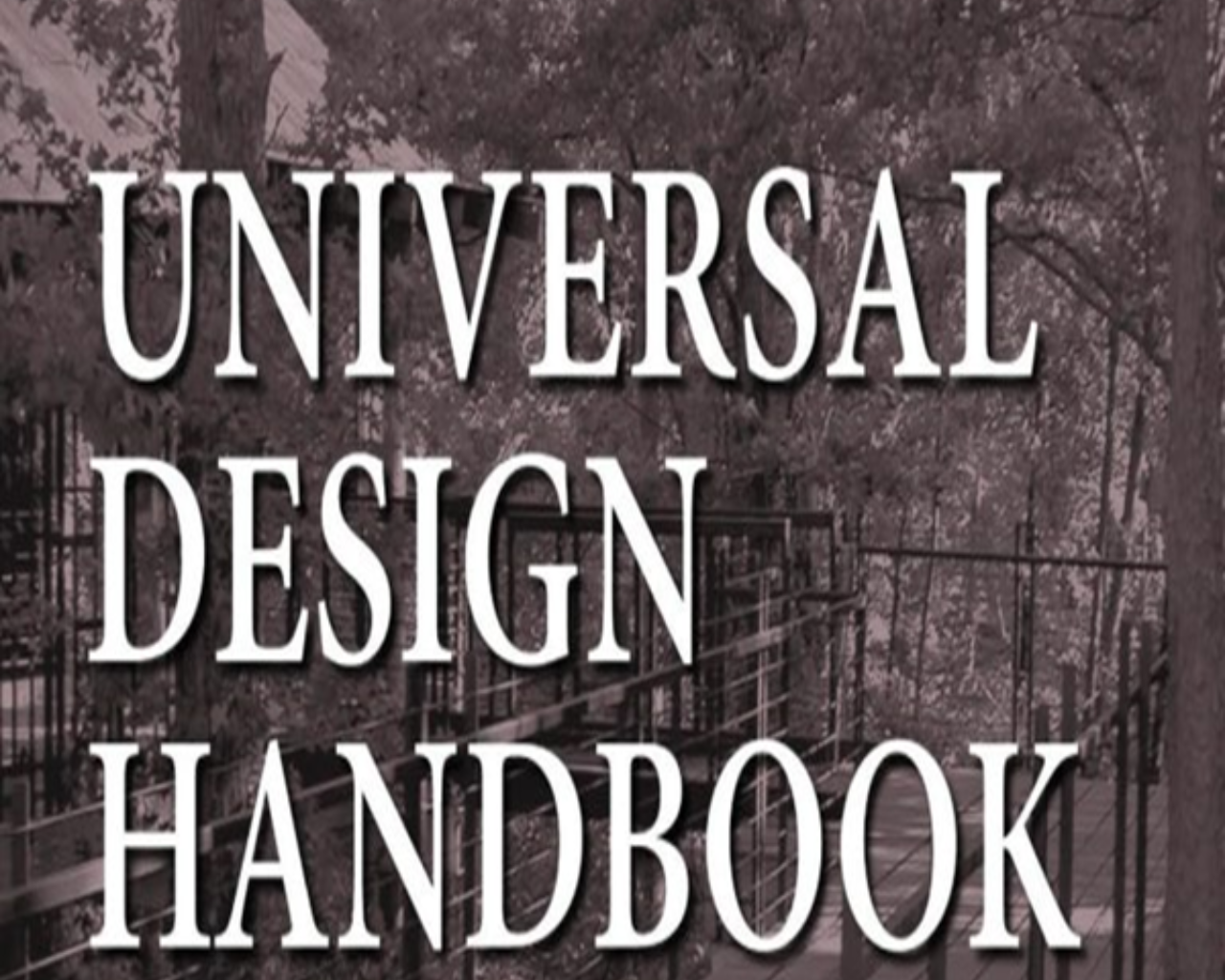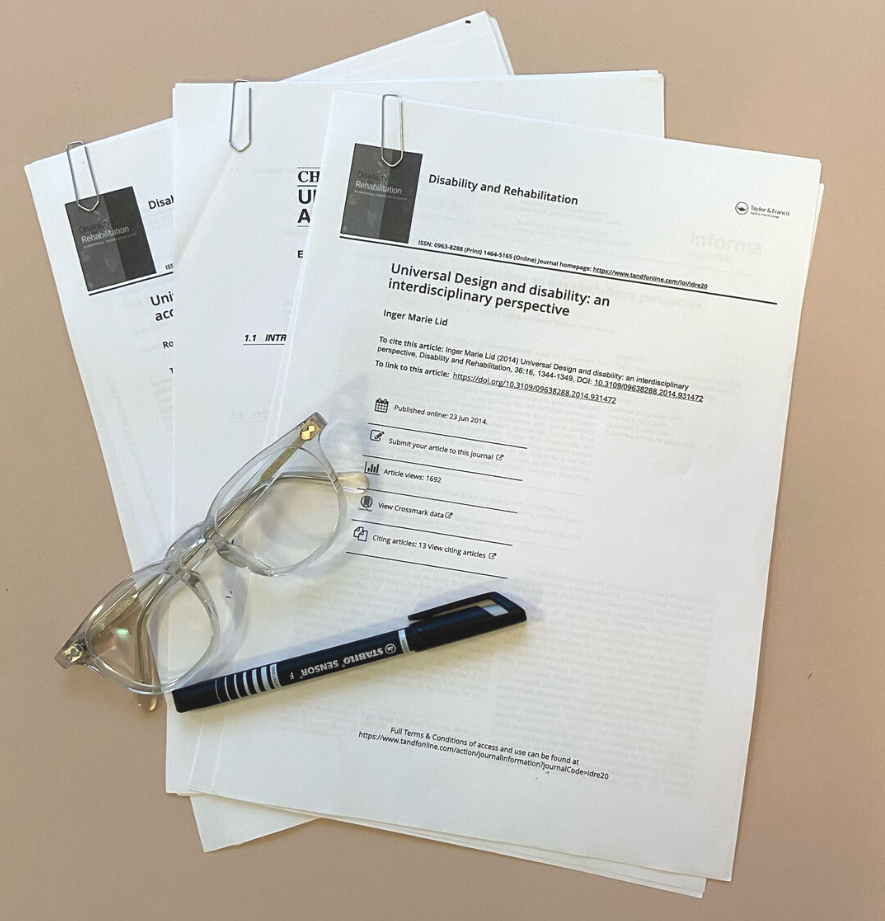Learn more: Universal Design
This module provides a mix of book chapters, digital talks and lectures, scientific papers, and a podcast on the general theme of Universal Design.
Universal design: an evolving paradigm
Reference: Ostroff, Elaine (2010) Universal design: an evolving paradigm. In: Universal Design Handbook. Preiser, Wolfgang & Ostroff, Elaine (eds.) New York: McGraw-Hill. Chapter 1, pp. 34-42.
Format: Text
Keywords: Introduction to Universal Design, Convention on the Rights of Persons with Disabilities (CRPD), Historical and Cultural perspective
Work load: 10 pages
Description: Elaine Ostroff introduces Universal Design as an evolving paradigm and offers a historical and cultural perspective by placing Universal Design in different contexts such as Universal Design and Education, Universal Design and Business, Universal Design and Society.

Principles of Universal Design
Reference: Story, Molly (2010) Principles of Universal Design. In: Universal Design Handbook, Edited by: Preiser, Wolfgang & Ostroff, Elaine. New York: McGraw-Hill. Chapter 4, pp. 58-67.
Format: Text
Keywords: The Principles of Universal Design, Contextual examples, Standards, Guidelines
Work load: 10 pages
Description: Molly Story introduces The Principles of Universal Design and exemplifies the use of the seven principles in various contexts as an attempt to articulate a concept that embraces human diversity and applies to all design disciplines.

Accessibility, usability and universal design positioning and definition of concepts describing person-environment relationships
Reference: Iwarsson, Susanne & Ståhl, Agneta (2003) Accessibility, usability and universal design positioning and definition of concepts describing person-environment relationships, Disability & Rehabilitation, 25:2, 57 – 66.
Format: Text
Keywords: Accessibility, Usability, Method, Universal Design
Work load: 9 pages
Description: This paper introduces an instrumental, three-step definition to accessibility, emphasising that accessibility includes personal as well as environmental components. Suggesting the introduction of an activity component, accessibility is replaced by a more complex term, usability. Universal Design is highlighted as a more process-oriented but less stigmatising concept.

Universal Design and disability: an interdisciplinary perspective
Reference: Lid, Inger Marie (2014) Universal Design and disability: an interdisciplinary perspective. Disability and Rehabilitation, 36:16, 1344-1349.
Format: Text
Keywords: Interdisciplinary Field of Knowledge, Convention on the Rights of Persons with Disabilities (CRPD), Human Plurality
Work load: 6 pages
Description: This is a theoretical paper. It discusses the understanding of Universal Design as an interdisciplinary theme and the significance of Universal Design in research and teaching. The paper builds on literature and focuses on how to recognise Universal Design in interdisciplinary contexts.

Universal Design
Reference: Ryhl, Camilla (2022) Universal Design. Universal Design Hub – Bevica Fonden.
Format: Video
Keywords: Concept, History, Inclusion, Disability
Work load: 3 minutes
Description: This video briefly summarizes the fundamentals of Universal Design. It examines the applicability of Universal Design and how it encompasses all aspects of our life. Ultimately, Universal design is a value-based design principle that ensures equal and inclusive solutions for all – regardless of abilities.
Doing Dis/ability and Architecture Differently
Reference: Boys, Jos (2016) Doing Dis/ability and Architecture Differently? AA School of Architecture.
Format: Video
Keywords: Perspectives on disability, Architecture, Gender, Understanding of normal
Work load: 1 hour 28 minutes
Description: In this video, Jos Boys discusses what can happen to architecture and its practices when ‘normal’ (and normative) assumptions about disability and ability are creatively and critically challenged. The video investigates our perceptions of normalcy, disability, and ability in the context of architecture.
An inclusive human view in design and architecture
Reference: The Royal Danish Academy (2022) An inclusive human view in design and architecture.
Format: Video
Keywords: Architecture, Design, Inclusion, Diversity, Co-creation
Work load: 6 minutes
Description: This video showcases how The Royal Danish Academy integrates Universal Design into their teaching and research as a lever for the Leave No One Behind agenda, and a general action of an inclusive view of humanity. It exemplifies how people of different capabilities may be included into design processes and how this inclusive approach can add quality and depth to the final design.
Link: https://www.bevica.dk/partnerskaber/universelt-design-og-tilgaengelighed-for-alle/
TEDxSydney: Designing for Function and Universal Access
Reference: Houbolt, Sarah (2017) TEDxSydney: Designing for Function and Universal Access. TEDx Talk.
Format: Video
Keywords: Human value, Human needs, User involvement, Accessibility, Innovation
Work load: 12 minutes
Description: In this TEDx Talk, Sara Houbolt argues how her experiences as visually impaired has taught her a bodily way to be with other people as an equal and valued contributor to space. She argues for the value of user involvement and co-creation in design processes and points out how we ought to “focus on fixing the environment first – rather than fixing our bodily experience of the world” – since, “integrating accessibility into the design process always leads to innovation”.
Nordisk kongres i Synspædagogik: Universelt design
Reference: Institut for Blinde og Svagsynede (2022) Blind Lyd – Podcast: 1. Nordisk kongres i Synspædagogik: Universelt design.
Format: Podcast
Keywords: Accessibility, Principles, View of humanity, Sustainable Development Goals
Work load: 33 minutes
Description: In this podcast episode, Research Director at Bevica Fonden, Camilla Ryhl, gives a lecture on Universal Design. She describes how Universal Design can be understood as a value-based principle, as a process tool or as a solution. She also argues for the importance of interdisciplinary collaboration in Universal Design.
Link: https://www.podbean.com/media/share/pb-65mkw-12dad45
Transcription of podcast: https://view.officeapps.live.com/op/view.aspx?src=https%3A%2F%2Fibos.dk%2Fwp-content%2Fuploads%2F2022%2F10%2FTransskribering-af-NKS-podcastserie_10.10.22.docx&wdOrigin=BROWSELINK
